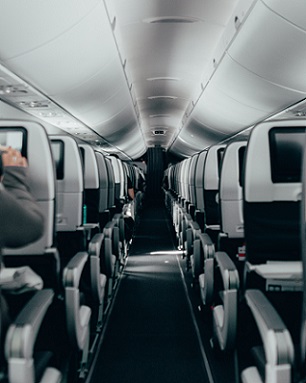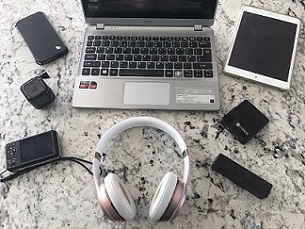 The confined space of a passenger cabin on an aircraft is the last place you’d want a lithium battery fire giving off heat and toxic smoke
The confined space of a passenger cabin on an aircraft is the last place you’d want a lithium battery fire giving off heat and toxic smoke
 A pilot with an AvSax lithium battery fire containment bag
A pilot with an AvSax lithium battery fire containment bag
 All these electronic gadgets are powered by lithium batteries
All these electronic gadgets are powered by lithium batteries
A passenger plane had to be diverted after a power bank caught fire on board.
The power bank had fallen between two seats, become crushed and started to emit smoke during the flight on August 14, 2023.
According to the Aviation Herald the China Eastern Airlines plane was flying from Lhasa in Tibet to Shanghai when the lithium fire happened while cruising at 35,000ft just 130 miles from Wuhan.
The pilots diverted to Wuhan where the plane landed safely just over 20 minutes later while the crew manage to retrieve the power bank and cool it.
According to the China Daily news website: “The airline reminded passengers in a social media post that they may not use power banks during the flight as they are likely to overheat in the cabin under a pressurised environment and may lead to self-combustion. The airline also reminded passengers they need to seek cabin crew for help if power banks fell into seat gaps to avoid risks.”
The danger posed by lithium batteries means cabin crew on airlines worldwide now warn people in pre-flight safety briefings to let them know immediately if their electronic device overheats or gets lost in the seat. The risk then is that if the seat is moved to try to find a missing power bank or mobile phone it could crush the device and trigger a thermal runaway fire which is what happened in this case.
Many airline companies are prepared for this risk by carrying special lithium battery fire mitigation bags on board and the brand used by the vast majority of airlines is the AvSax designed by Environmental Defence Systems Ltd based in Huddersfield, Yorkshire, UK.
AvSax won the Queen’s Award for Enterprise in the UK for its innovation – the highest award any business can get.
They are now on board over 16,750 aircraft operated by more than 100 airline companies worldwide, including some of the best-known names in the aviation industry. AvSax have been deployed in action at least 33 times on board aircraft since 2017 and on every occasion the aircraft was able to continue safely to its destination with no need to divert or make an emergency landing which can be both costly and disruptive to the airline.
AvSax are made from military grade material so even if the overheating electronic device explodes the bag is designed to contain it.
Jessica Bailey from Environmental Defence Systems Ltd said: “The last place anyone wants a lithium battery fire is in the confined space of an aircraft cruising at 35,000ft which is what happened in this case and so the pilots decided to make an emergency landing.
“It’s vital passengers alert cabin crew immediately if their electronic device starts to overheat or they’ve lost it down seats.”
When lithium batteries overheat or are damaged it can spark a chemical process called thermal runaway and when this happens it can produce enough heat – up to 900°C (1652°F) – to cause adjacent cells to overheat.
This can cause a lithium battery fire to flare repeatedly and they are then very difficult to put out which is why it must go into a lithium battery fire containment bag as quickly as possible on an aircraft.
The only thermal mitigation bag which will continually cool the overheating device once it’s placed in there is the AvSax as it works by adding water to the bag.
This is the process preferred by the CAA in the UK, which states in its guidance: “Since the development of the International Civil Aviation Organization (ICAO) guidance on dealing with an in-flight battery fire, new products designed for use in response to lithium battery thermal runaway events have become available.
“Products which provide both a cooling and containment capability are typically more aligned to the existing ICAO guidance as when used they are filled with water or other non-flammable liquid to act as a cooling agent.
“After knocking down flames it could conceivably take just a couple of seconds for a personal electronic device to be placed inside a containment bag, allowing it to be moved to a place of safety. Passengers could then return to their seats, mitigating potential unrelated safety hazards such as injury in the case of severe turbulence. Equally, the effect on flight crew in carrying out their duties following an event on the flight deck would be minimised.”
For more information on AvSax go to www.avsax.com